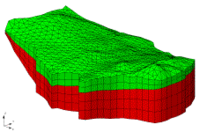GMS:FEMWATER Point / Arc Properties: Difference between revisions
From XMS Wiki
Jump to navigationJump to search
No edit summary |
|||
| Line 3: | Line 3: | ||
===Point Properties=== | ===Point Properties=== | ||
Points in a FEMWATER coverage are used to define injection and extraction wells. The point attributes are edited via the ''Point Properties'' dialog. The Point Attributes dialog is accessed by [[GMS:Feature Object Tool Palette|selecting a point(s)]] and then selecting the Attribute Table command in the coverage right click option menu. Each point's properties are displayed in the spreadsheet. The options in the dialog are as follows. | Points in a FEMWATER coverage are used to define injection and extraction wells. The point attributes are edited via the ''Point Properties'' dialog. The ''Point Attributes'' dialog is accessed by [[GMS:Feature Object Tool Palette|selecting a point(s)]] and then selecting the '''Attribute Table''' command in the coverage right-click option menu. Each point's properties are displayed in the spreadsheet. The options in the dialog are as follows. | ||
:'''Type''' – The type of point can be changed to either a well or an observation point. These options are available depending on what was selected in the ''Coverage Setup Dialog''. The type for each point is defaulted to "NONE" in the '''Type''' column pull-down list. | :'''Type''' – The type of point can be changed to either a well or an observation point. These options are available depending on what was selected in the ''Coverage Setup Dialog''. The type for each point is defaulted to "NONE" in the '''Type''' column pull-down list. | ||
| Line 14: | Line 14: | ||
:[[Image:screenlogic.gif|frame|center|''The Distribution of Flux Rate to Nodes Overlapped by Well Screen.''|225px]] | :[[Image:screenlogic.gif|frame|center|''The Distribution of Flux Rate to Nodes Overlapped by Well Screen.''|225px]] | ||
[[Category:GMS Dialogs|F]] | |||
===Arc Properties=== | ===Arc Properties=== | ||
